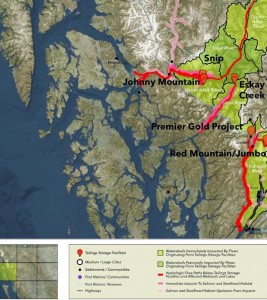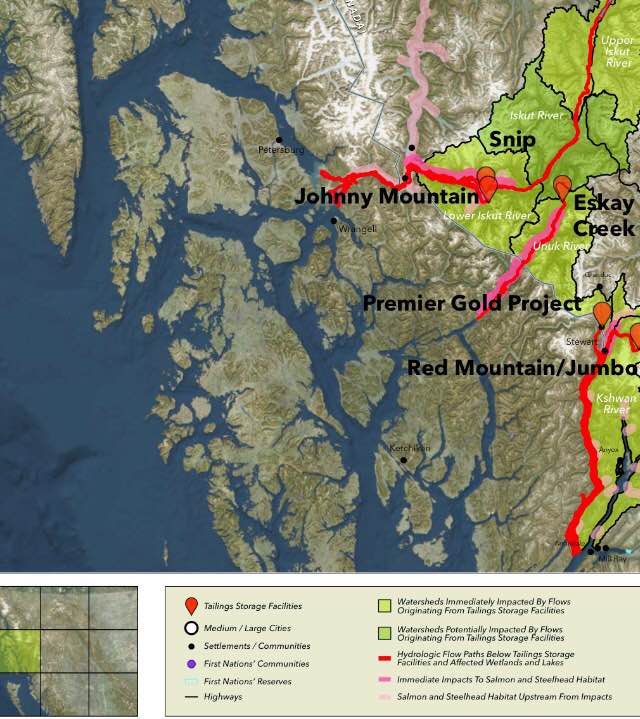
This map, found in the FNMEC report, shows potential contaminant flow paths from B.C. tailings dams into Southeast Alaska waters.
Thousands of miles of salmon habitat and more than 200 communities across Southeast Alaska and British Columbia could be affected if another mine disaster happens near the border. According to a report released this week by a B.C. First Nations group, 35 tailings ponds in the region are drawing more scrutiny after a mine dam collapsed last summer.
The report, titled “Uncertainty Upstream: Potential Threats from Tailings Facility Failures in Northern British Columbia,” quantifies what could be at stake.
The B.C. First Nations Energy and Mining Council lists watersheds, communities and salmon habitat that could be affected by tailings facilities that are upstream from Southeast Alaska.
The tailings dam system for mine waste management is facing a lot of criticism after a dam at the Mount Polley Mine in central B.C. collapsed last summer. It spilled millions of gallons of waste into Canadian waterways.
B.C. First Nations Energy and Mining Council CEO Dave Porter said this report is a follow-up to an expert panel’s findings about the cause of last summer’s dam breach.
“Given the state of the regulatory legal framework governing the mining industry here in B.C., the panel said we can expect two more such failures in the next decade. Well, from our perspective, that’s unacceptable,” Porter said. “So we believe that it is the responsibility of government, industry and our communities to prepare for such an eventuality.”
His organization compiled this report as a resource tool to help communities understand what the potential risks are to nearby watersheds and fish populations.
According to the report, there are 35 tailings ponds from the Mount Polley mine up to the Yukon border. More than 200 communities in mainland B.C. could be affected by a failure. The study does not list towns in Southeast Alaska, but it does include rivers that flow into Alaskan waters.
Three tailings dams are upriver from Wrangell and Petersburg. Two tailings dams are in the Unuk River watershed, which ends near Ketchikan. There is a tailings dam that could eventually affect the Juneau area and one that could impact Haines and Skagway.
Southeast Alaskans worry B.C. mines could destroy salmon and other wildlife that many people depend on for subsistence and income.
The study finds 80 percent of king and sockeye salmon freshwater habitat in the region is either downstream of a tailings facility or would require migrating through a potential contaminant flow path. The same is true for about half of coho, chum and pink salmon habitat.
The report calls for some changes in B.C.’s approach to mining. The energy and mining council asks for more involvement of indigenous communities in the mine planning process and for more long-term economic benefits to settlements affected by mining. It also asks for an emphasis on protecting entire watersheds and to create a pool of money to help with clean-up in the event of a tailings dam failure.
Karina Briño is CEO of the Mining Association of British Columbia. She said laws are already in place to deal with almost all of those requests.
“I think what this recommendation is doing and what this report is doing is it’s enhancing the opportunity that we have, as an industry, to have those conversations at a more local level,” Briño said.
As B.C.’s mining boom continues, more mines with tailings ponds are planned for the region.












